 CIP Beam ( Modeling > F2 >
CIP Beam ( Modeling > F2 >  Concrete / Rebar > select " CIP Beam ")
Concrete / Rebar > select " CIP Beam ")
Tool summary :
The Cast in Place Beam Edit window :
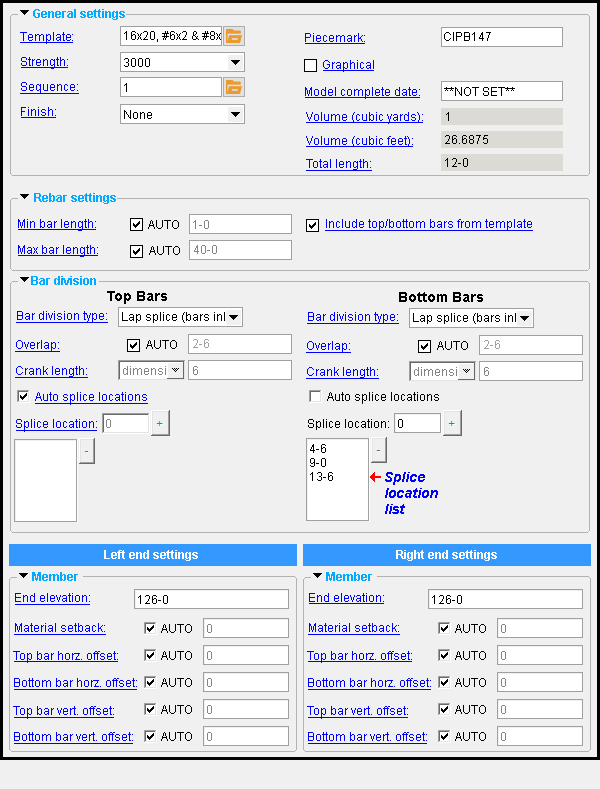
|
To open the Cast in Place Beam Edit window :
- With the Default filter selected, double-click a cast in place beam member.
- Add a cast in place beam .
On this page :
Also see :
- Modeling (where a cast in place beam can be added or edited)
- cast in place beam (definition)
- Beam Templates (setup window that lists available cast in place beam templates)
- Beam Template Editor (setup window with settings for adding/editing/reviewing an individual template)
- Tie Zone (may be added to a cast in place beam)
concrete | F2 > concrete / rebar > cip beam | cast in place beam | top
 To add a cast in place beam :
To add a cast in place beam :
Before adding a cast in place beam , you should confirm that the " Template " that you want to use for the beam has been properly set up on the Beam Templates window. The template sets, for example, whether the profile of the beam is rectangular or an irregular shape.
A cast in place beam can be added in Modeling by pressing F2 to open the Member Type Selection window, then double-clicking " Cast in Place Beam ."
Two work points are required to add a beam. The order in which you locate these points does not matter since the work point that is closest to the global axes 0, 0, 0 point is recorded as the " Left end " work point. This is exactly the same way that the left end is determined for steel beams. Click here for more information on the topic of how a member's left end relates to global coordinates.
Cast in place beams can be sloping or non-sloping. The member line of a cast in place beam will adjust to a change in that member's " End elevation ."
For more information related to locating the work points for a cast in place beam member, familiarize yourself with the following help topics: Offset Controls for point location , Locators , Locate menu, point location target (
), status line , X-Y-Z display , global coordinate system .
concrete | F2 > concrete / rebar > cip beam | cast in place beam | top
| cast in place beam properties |
------  Rebar settings ------
Rebar settings ------
Include top/bottom bars from template: ![]() or
or ![]() . This applies to cast in place beams when dowels have been defined in the selected " Template ." These are the reinforcing bars that run along the length of the cast in place beam.
. This applies to cast in place beams when dowels have been defined in the selected " Template ." These are the reinforcing bars that run along the length of the cast in place beam.
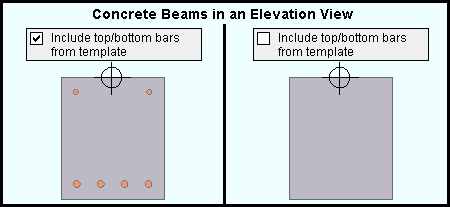
If this box is checked (
), longitudinal reinforcing bars that are defined in the " Template " are included in the cast in place beam. Ties can be added to the bars using " Tie Zone ."
If the box is not checked (
), the rebar defined in the beam template ( Beam Templates ) is not included in the beam. If you so choose, you can add a system of longitudinal reinforcing bars using a Rebar Area Layout .
Max bar length: ![]() AUTO or
AUTO or ![]() AUTO . This applies when the option to "
AUTO . This applies when the option to " ![]() Include dowels from template " is checked.
Include dowels from template " is checked.
'
AUTO (checked) ' instructs the Cast in Place Beam program to determine the " Max bar length ." The bar is spliced so that the " Stock / max fab length " and the " Max mill length " of the bar's reinforcing bar definition is not exceeded.
'
AUTO (not checked) ' lets you enter a distance in the primary dimension " Units " or other units .
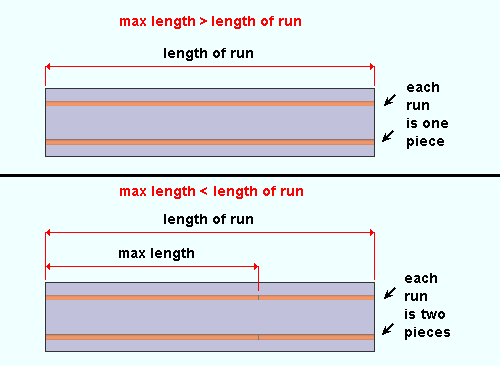
Max length >= length of run: If the " Max bar length " that is entered is greater than or equal to the length of the rebar run, the rebar run will consist of a single rebar that is the required length.
Max length < length of run: If the " Max bar length " that is entered is less than the length of run that is required and the cast in place beam program does not override your entry due to " Min bar length " being set to '
AUTO ', the rebar run is broken two or more rebar lengths, the first of which is (or are) the " Max bar length ."
Example: " Max bar length " results in each rebar run in the cast in place beam being divided into three rebar segments. The first two segments are the " Max bar length ." The third segment is the length that is required to complete the run.
Note: A " Max bar length " that is less than the " Min bar length " is an invalid entry. You need to change that setting, or you will not be able to close the Cast in Place Beam Edit window using " OK ".
Min bar length: ![]() AUTO or
AUTO or ![]() AUTO . This applies when the option to "
AUTO . This applies when the option to " ![]() Include dowels from template " is checked.
Include dowels from template " is checked.
'
AUTO (checked) ' instructs the cast in place beam program to determine the " Min bar length ." Be aware that when '
AUTO ' is checked, a distance that you enter for " Max bar length " may be overridden.
'
AUTO (not checked) ' lets you enter a distance in the primary dimension " Units " or other units . Be aware that this distance may not be applied when a specific " Max bar length " has been entered.
concrete | F2 > concrete / rebar > cip beam | cast in place beam | top
------  Bar division ------
Bar division ------
Bar division: None or Lap splice (bars inline) or Lap splice (bars offset) or Crank splice . These options determine if or how bars are spliced.
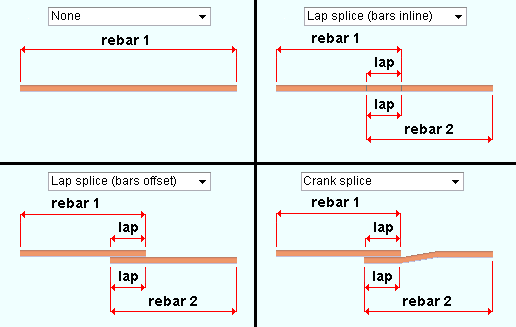
|
| Bar division settings affect the length of rebar shape material. |
The ' None ' option prevents splices from being modeled. The rebar is modeled as a single length.
The ' Lap splice (bars inline) ' option models splices that accommodate the " Max bar length " and the " Overlap "; however, the splices are within the same rebar run and are modeled as clashing material.
The ' Lap splice (bars offset) ' option models splices that accommodate the " Max bar length " and the " Overlap ". The bars are offset so that their material does not clash.
The ' Crank splice ' option models splices that accommodate the " Max bar length " and the " Overlap ". The bars are within the same rebar run, but cranks are provided that conform to the " Crank length " options to prevent the bars from clashing.
Overlap: ![]() AUTO or
AUTO or ![]() AUTO . This applies when the runs of horizontal rebar have been divided into multiple rebar lengths to accommodate the " Max bar length ." A lap splice is a common way of splicing two reinforcing bars. Lap splices that are within the same rebar run are modeled as a material clash between the two lengths of rebar that are being spliced. The length that the rebar clashes in the model is the " Overlap " that has been entered.
AUTO . This applies when the runs of horizontal rebar have been divided into multiple rebar lengths to accommodate the " Max bar length ." A lap splice is a common way of splicing two reinforcing bars. Lap splices that are within the same rebar run are modeled as a material clash between the two lengths of rebar that are being spliced. The length that the rebar clashes in the model is the " Overlap " that has been entered.
'
AUTO (checked) ' instructs the cast in place beam program to determine the " Overlap ." If the program applies splices, the overlap will be the " Horz. in concrete " distance entered in the Reinforcing Bar Definitions window for the size of rebar in the run.
'
AUTO (not checked) ' lets you enter a distance in the primary dimension " Units " or other units . That user-entered lap length applies when the " Max bar length " results in each run of longitudinal rebar being divided into multiple rebar lengths. The diagram below shows a single rebar run. Since rebar 2 requires two lap splices, the " Overlap " (marked lap in the diagram) is applied twice.

|
| Entering an appropriate " Overlap " ensures that sufficient lengths of rebar are ordered to achieve a lap splice. As shown in this diagram, a lap splice that is within the same rebar run is modeled as a material clash. |
Crank length: ratio or dimension . This option applies when " Bar division type " is ' Crank splice '.
' ratio ' specifies the ratio (expressed as a decimal number) of the crank length to bar size; that is, the crank length divided by the bar size. It follows that if you multiply the ratio by the bar size, you can calculate the resulting crank length:
Crank length example using imperial units :
ratio = ' 6.0 '
bar size = #6 (i.e. 3/4", or 0.75 )
crank length = CC ÷ 0.75 = 6.0
C = 6.0 × 0.75
C = 4.5 , or 4 1/2"Crank length example using metric units :
ratio = ' 6.0 '
bar size = #19 (i.e. 19 mm)
crank length = CC ÷ 19 = 6.0
C = 6.0 × 19
C = 114 mm' dimension ' allow you to enter the crank length as a distance in the primary dimension " Units " or other units .
'
AUTO (checked) ' instructs the concrete beam program to automatically calculate the location of rebar splices.
When " Max bar length " is " Auto ," the bar is spliced so that the " Stock / max fab length " and the " Max mill length " of the bar's reinforcing bar definition is not exceeded.
When " Max bar length " is not " Auto ," the bar is spliced so that the " Max bar length " is not exceeded.
'
AUTO (not checked) ' lets you enter one or more distances in the primary dimension " Units " or other units to the Splice location list .
Splice location: A distance (in the primary dimension " Units " or other units ). When the " Auto splice locations " option is unchecked ( ![]() ), this option lets you add one or more splice locations to the Splice location list .
), this option lets you add one or more splice locations to the Splice location list .
To add a splice location :
1 . Enter a dimension into the " Splice location " field. This will locate a splice from the left end of the beam's concrete material, not the beam's left end. This means that " Material setback " distances affect the placement of rebar splices.
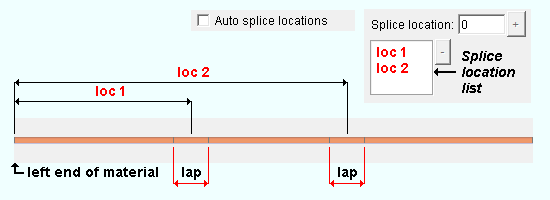
2 . Click the "+" button. The dimension is then added to the Splice location list . Note that list entries are automatically ordered from smallest to largest.
To remove a splice location :
1 . Click to highlight the location's dimension in the Splice location list .
2 . Click the "-" button. The dimension is then removed from the Splice location list .
concrete | F2 > concrete / rebar > cip beam | cast in place beam | top
|
|
|
------  Member ------
Member ------
End elevation: The elevation (in the primary dimension " Units " or other units ) of the work point at the top of this end of the cast in place beam. For a non-sloping cast in place beam, both the left and right end elevations will be the same.
|
|
| A cast in place beam has two exact points , whose elevation you can change by changing the member's left- and/or right-end " End elevation ." |
To determine the end elevation on a cast in place beam in the 3D model , use Construction Line Add or a similar tool, select EXPT as the Locate option, then snap the point location target to the work point at the end of the beam. The Z coordinate reported in the X-Y-Z display tells you the elevation at the snapped-to exact point.
Material setback: ![]() AUTO or
AUTO or ![]() AUTO .
AUTO .
'
AUTO (checked) ' instructs the concrete beam program to automatically calculate the left-end " Material setback " and right-end " Material setback " for beam-to-column framing situations such as that shown below.
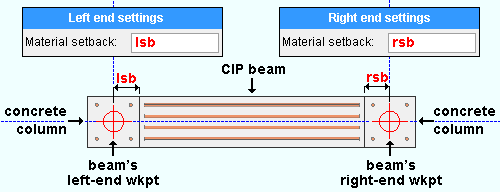
In the above example, the cast in place beam's left-end " Material setback " ( lsb ) and the right-end " Material setback " ( rsb ) is the half-depth of the concrete column.
The " Material setback " adjusts the length of the cast in place beam. It also affects the " Volume (yards) " and " Total length " that is reported for the cast in place beam.
'
AUTO (not checked) ' lets you enter a distance in the primary dimension " Units " or other units .
Top bar horz. offset: ![]() AUTO or
AUTO or ![]() AUTO . This option applies when the option " Include top/bottom bars from template " is checked (
AUTO . This option applies when the option " Include top/bottom bars from template " is checked ( ![]() ), and when top dowels have been defined in the selected " Template ."
), and when top dowels have been defined in the selected " Template ."
'
AUTO (checked) ' instructs the concrete beam program to automatically calculate the left-end " Top bar horz. offset " and right-end " Top bar horz. offset " for beam-to-column framing situations such as that shown below.
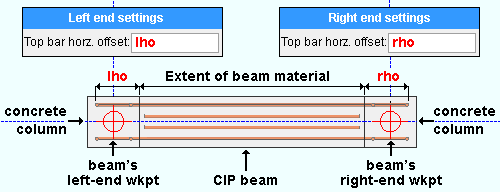
In the above example, the cast in place beam's left-end " Top bar horz. offset " ( lho ) is the horizontal distance from the left-end of the cast in place beam's material to the left ends of the top bars. Likewise, the right-end " Top bar horz. offset " ( rho ) is the horizontal distance from the right-end of the cast in place beam's material to the right ends of the top bars. The end's " Material setback " entry determines the extent of the material at each end.
The " Top bar horz. offset " adjusts the length of the top reinforcing bar.
'
AUTO (not checked) ' lets you enter a distance in the primary dimension " Units " or other units .
Bottom bar horz. offset: ![]() AUTO or
AUTO or ![]() AUTO . This option applies when the option " Include top/bottom bars from template " is checked (
AUTO . This option applies when the option " Include top/bottom bars from template " is checked ( ![]() ), and when bottom dowels have been defined in the selected " Template ."
), and when bottom dowels have been defined in the selected " Template ."
'
AUTO (checked) ' instructs the concrete beam program to automatically calculate the left-end " Bottom bar horz. offset " and right-end " Bottom bar horz. offset " for beam-to-column framing situations. This option has the same effect as the " Top bar horz. offset " option, except that it adjusts the length of the bottom reinforcing bar.
'
AUTO (not checked) ' lets you enter a distance in the primary dimension " Units " or other units .
Top bar vert. offset: ![]() AUTO or
AUTO or ![]() AUTO . This option applies when the option " Include top/bottom bars from template " is checked (
AUTO . This option applies when the option " Include top/bottom bars from template " is checked ( ![]() ), and when top dowels have been defined in the selected " Template ."
), and when top dowels have been defined in the selected " Template ."
'
AUTO (checked) ' instructs the concrete beam program to automatically calculate the left-end " Top bar vert. offset " and right-end " Top bar vert. offset " as shown below.
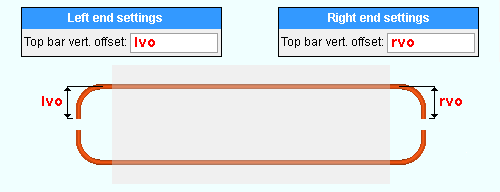
'
AUTO (not checked) ' lets you enter a distance in the primary dimension " Units " or other units .
The " Top bar vert. offset " adjusts the length of the top reinforcing bar.
Bottom bar vert. offset: ![]() AUTO or
AUTO or ![]() AUTO . This option applies when the option " Include top/bottom bars from template " is checked (
AUTO . This option applies when the option " Include top/bottom bars from template " is checked ( ![]() ), and when bottom dowels have been defined in the selected " Template ."
), and when bottom dowels have been defined in the selected " Template ."
'
AUTO (checked) ' instructs the concrete beam program to automatically calculate the left-end " Bottom bar vert. offset " and right-end " Bottom bar vert. offset " as shown below
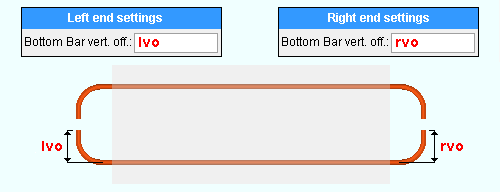
'
AUTO (not checked) ' lets you enter a distance in the primary dimension " Units " or other units .
The " Bottom bar vert. offset " adjusts the length of the bottom reinforcing bar.
concrete | F2 > concrete / rebar > cip beam | cast in place beam | top








